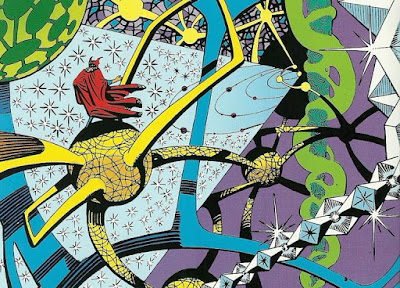A cinematic genius who could do his finished drawings in a single take. Wow!
 |
| Storyboard with notes by Jack Kirby, provenance unknown. |
I was leafing through Facebook the other day and came across the above storyboard. Not only is it brilliantly composed, but it is worked out in a single draft across the panels. That’s essentially backwards from the way most artists work. We start slowly, letting our fingers work out the ideas through multiple sketches. But nothing about this work is haphazard.
This is the work of that most brilliant American artist of the 20th century,
Jack Kirby. To understand him better, I consulted
Alan Spinney, who’s been reading and drawing comics forever.
 |
| Pencil panels along with final inked versions. Kirby did not ink his own work. Courtesy of Alan Spinney. |
“Jack Kirby was one of the fastest comic artists in history, and was kind of driven,” Spinney told me. Kirby did not make preliminary sketches, rough work or layouts. He started work directly on his board. He rarely erased, the story having flowed from his mind fully formed.
 |
| Pencil art from Fantastic Four, courtesy of Alan Spinney, from TwoMorrow’s Publishing. |
Kirby was raised in the tenements of Manhattan’s Lower East Side, the son of a garment worker. Perhaps that’s how he learned to work so fast. He taught himself to draw by tracing characters from comic strips and editorial cartoons. At age 14, he enrolled at the
Pratt Institute. He lasted exactly one week.
 |
| Black Panther concept by Jack Kirby, courtesy of Alan Spinney, from TwoMorrow’s Publishing. |
“I wasn’t the kind of student that Pratt was looking for. They wanted people who would work on something forever. I didn’t want to work on any project forever. I intended to get things done.” Kirby got his first professional drawing gig at the tender age of 19.
His meeting with
Joe Simon resulted in the creation of
Captain America and a working partnership that would last a decade and a half.
“I had a suit and Jack thought that was really nice. He’d never seen a comic book artist with a suit before. The reason I had a suit was that my father was a tailor. Jack’s father was a tailor too, but he made pants,” said Simon.
 |
| One of Jack Kirby’s fantastical machines. Courtesy of Alan Spinney. |
Knowing his star artists were about to be drafted into WW2, their publisher asked them to ‘bank’ material. The pair hired writers, inkers, letterers and colorists and created a year’s worth of panels.
Kirby went on to repeat a similar performance in the 1960s, with
Stan Lee.
“He would do script breakdowns for other artists to draw from, like thumbnails,” Spinney said. “They would finish the drawings and ink them, so all the books looked like Kirby drew them.”
 |
| From Jack Kirby Quarterly, published by TwoMorrow’s Publishing. |
Jack Kirby was, above all, dynamic. He pushed people through his stories in a cinematic way. “I found myself competing with the movie camera. I had to compete with the camera. I felt like
John Henry … I tore my characters out of the panels. I made them jump all over the page. I tried to make that cohesive so that it would be easier to read. I had to get my characters in extreme positions, and in doing so I created an extreme style, which was recognizable by everybody,” Kirby said.
“Marvel worked very loosely; Kirby and Stan Lee would chat about a story, Kirby would draw it and then Lee would write the dialogue,” said Spinney. “Kirby was famous for his machines, his character design, and high drama in his figures.”
 |
| Photocopy of page from Fantastic Four, courtesy of Alan Spinney, from TwoMorrow’s Publishing |
His collaboration with Lee resulted in more abstraction, foreshortening and diagonal motion, all relentlessly driving the reader. It also resulted in a Pantheon of superheroes who have influenced all comic art since.
“
Jack Kirby was the
William Blake of comics and
New Gods was his masterpiece, an epic cosmic war between evil gods and good gods,”
wroteGrant Morrison. Comic books may seem trivial to some, but in the hands of a master, they dealt with the deepest issues of our times.









